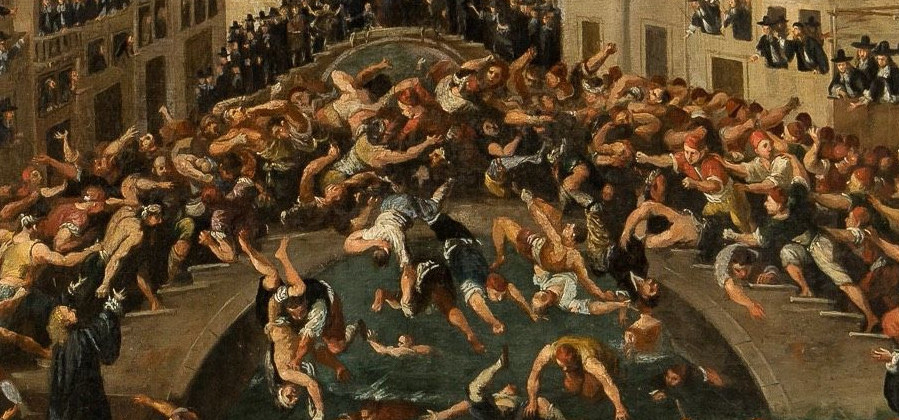
Castellani and Nicolotti, a story of a rivalry
If there is something that all Italians have in common, it is the tendency to divide into factions: rivalry between Ghibellines and Guelphs, Bianchi and Neri, rivalry between cities , districts, parishes and families.
Even Venice was no …
If there is something that all Italians have in common, it is the tendency to divide into factions: rivalry between Ghibellines and Guelphs, Bianchi and Neri, rivalry between cities , districts, parishes and families.
Even Venice was no exception. For centuries, two factions competed, more as rivals than as enemies, in games and challenges: The Castellani and the Nicolotti.
Since the XII century, when the Doge was Vitale II Michiel, Venice was divided into six districts called Sestieri. It seems that the division had become necessary due to the continuous tensions between those who lived in the eastern area (the Sestieri of San Marco, Castello and part of Dorsoduro) and those who lived in the western area (Sestieri di Santa Croce, San Polo and of the part of Dorsoduro which belongs to the parish of San Nicolò dei Mendicoli).
This fierce rivalry probably dated back to the civil wars between the two ancient Roman cities of Eraclea and Equilio (Jesolo). Their inhabitants, following the barbarian invasions, had found refuge on the islands of the lagoon but, since the hatchet had never been completely buried, they had chosen to occupy areas well distant from each other.
Over the centuries the hatreds dissolved into a goliardic rivalry that the Serenissima encouraged with the intent to accustom young people to struggle and physical fatigue. In the event of a war, this prowess would have proved as an advantage. It was with this intent that games and challenges were promoted.
The day when the Nicolotti, with black hat and scarf, and the Castellani, with red hat and scarf, challenged each other was Fat Thursday during the Venice Carnival. The show took place in Saint Mark’s square and the doge attended from the balcony of the Doge’s Palace among the ambassadors and aristocrats.
For years, the festive day started with the sacrifice of one bull and twelve pigs. Each animal’s head had to fall with a single saber blow. The best team at cutting off the heads won the game and the team that had won the previous year had the honour to try to cut the bull’s head. Obviously, all this took place to the loud laughter and mocking of the audience.
After this, the balance games begun. The most famous was called “The Forces of Hercules” and it was a a human pyramid, with the help of sticks. The winner was the team who managed to form the highest pyramid. Another challenging balance game was performed by placing each foot on the iron of two gondolas and thus remaining in balance holding up to three people on the shoulders or on the head.
So many other balance games were performed on that day and they had strange and suggestive names: L’Anera, I Tre Ponti, La Imperiale Carega , La Bella Venezia , La Fondamenta dei Pensieri , i Quattro Angoli Sovra le Crosette, la Fuma, il Castello, Il Gaffaro, I Due Ponti, la Mezza Rosetta, la Gloria.
From September until Christmas, some Venetian bridges turned into a boxing ring to allow the fist-fights.
The most famous one was the bridge located near Campo San Barnaba, which is still called “Ponte dei Pugni” “bridge of the fists” . On the corners are still visible the footprints that marked the initial position of the wrestlers. These bridges had no side railings because falling into the water meant to lose the game.
These fights were abolished in 1705, after the Ponte dei Pugni was the scene of a bloody fight that started with the punches but ended with the knives. The battle lasted more than a day and there were many victims. Only the intervention of the parish priest of San Barnaba, who raised the crucifix invoking the help of God, managed to restore peace.
After that episode, only balance games and regattas were allowed.
And today, what is left of this rivalry? Not much, maybe nothing. But if we really want to dig, isn’t the current rivalry between Venice and Mestre a legacy of times gone by?





 HOTEL CARLTON CAPRI
HOTEL CARLTON CAPRI LA CUPOLA RESTAURANT
LA CUPOLA RESTAURANT TOP OF THE CARLTON SKY LOUNGE
TOP OF THE CARLTON SKY LOUNGE HOTEL CARLTON ON THE GRAND CANAL
HOTEL CARLTON ON THE GRAND CANAL

















